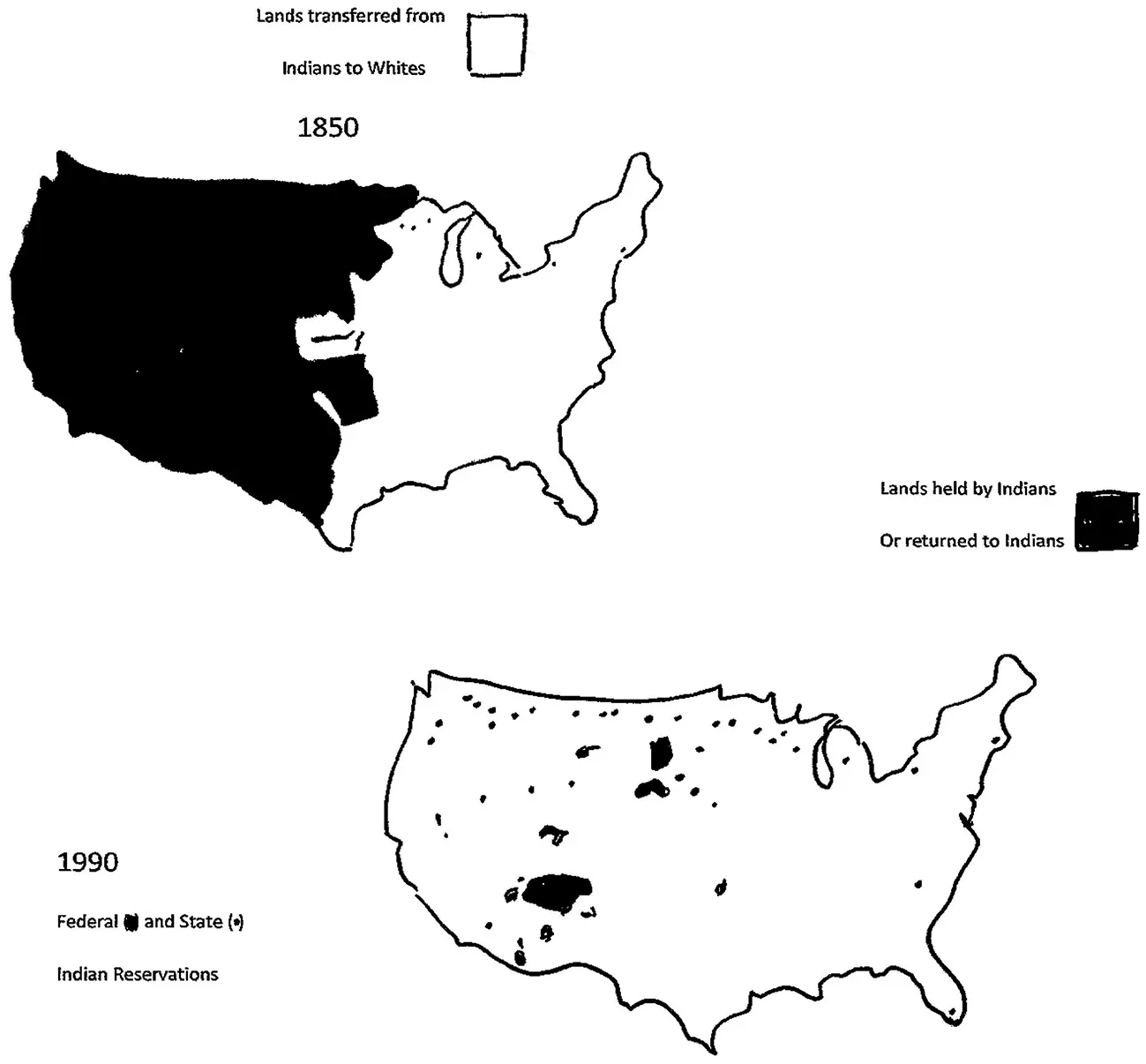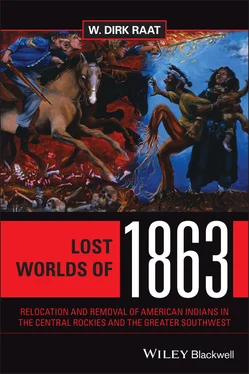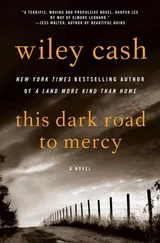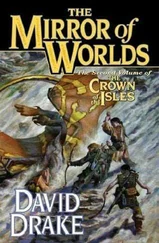
Figure 0-1 The Progression of Land Loss . Reconfiguration by Geraldine Raat of information found in Peter Nabokov’s “The Closing In” in Part Four of Native Americans: An Illustrated History (Atlanta: Turner Publishing Inc., 1993), p. 369.
(Central Rockies and Great Basin).
Surprise, Arizona
Prologue: Indigenous People in a Global Context Myth, Struggle and Survival
Every human group has a creation myth. White Americans are no exception. Their most popular origin myth concerns the frontier: Europe was crowded; North America was not. Land in Europe was claimed, owned and utilized; land in North America was available for the taking. In a migration as elemental as a law of physics, Europeans moved from crowded space to open space, where free land restored opportunity and offered a route to independence… . Thrown on their own resources, pioneers recreated the social contract from scratch, forming simple democratic communities whose political health vitalized all of America. Indians, symbolic residents of the wilderness, resisted— in a struggle sometimes noble, but always futile. At the completion of the conquest, that chapter of history was closed. The frontier ended, but the hardiness and independence of the pioneer survived in American character .
Patricia Nelson Limerick, The Legacy of Conquest 1
At first there were few white people, and they were all going west; then, as wise old Nana knew, the lure of gold, discovered far to our west, brought them in hordes. Though most of them went on, some stayed to burrow into Mother Earth for the ore sacred to Ussen. Nana was right in thinking that gold was to bring about our extermination .
Ace Dalugie, patriarch of the Mescalero Reservation Son of Juh, Leader of the Nednhi Apache 2
This is a study of relocation and removal of Indian groups in the Greater American Southwest centering on the events of the nineteenth century. Relocation, of course, is not only a nineteenth century phenomenon in American history. During World War II there were ten concentration camps operated by the War Relocation Authority, of which the largest was the Poston War Relocation Center in Yuma County (now La Paz County) in southwestern Arizona. Most of the Japanese Americans living in California, 110,000 of them, were moved to Poston and other centers, including the Gila River War Relocation Center 30 miles southeast of Phoenix. Del Webb built Poston on the Colorado River Indian Reservation over the objections of the tribal council (just as the Gila River Center, located on the Gila River Indian Reservation near Sacaton, Arizona, was built over the strong objections of that reservation’s American Indian government). It is a sad irony of western history that Indians, who themselves had been rounded up 80 or so years ago to be relocated and imprisoned on unfamiliar and hostile terrain, would now be forcibly hosting a new generation of Japanese American prisoners. 3
Relocation policy was not only targeted at Japanese Americans and Indian communities, tribes, and bands, but at nuclear families and individual family heads. The Indian Relocation Act of 1956 encouraged Native Americans as individuals to leave the reservation and assimilate into the general population, i.e., urbanization of the indigenous person. The law provided for moving expenses, vocational training, four weeks of subsistence per diem, and other grants as long as the recipient went to a government designated city. By 1960 over 31,000 indigenous individuals had moved to cities. Alas, the long term effects were devastating with individuals and their families suffering from isolation, racial discrimination, and segregation. However, an unintended result was the formation of the American Indian Movement in 1968, a group that was directed by “urbanized” Indians. 4But, of course, the removal and relocation of 1863 is the concern of this work.
Obviously, to understand that year the reader should study events that occurred both before and after 1863, and that is what this study does. But there can be no denying the importance of that year. For example, 1863 was the date of the Emancipation Proclamation; when Lincoln, attempting to foster patriotism during the Civil War, declared Thanksgiving a national holiday; the beginning of the Long Walk of the Navajo; the year of the Numa (Paiute) Path of Tears; the death of Mangas Coloradas and an acceleration of the Apache wars; the Bear River Massacre of Shoshone men, women, and children; when the Comanche leader Quanah Parker became a warrior; and when precious mineral seekers encroached upon Yavapai, Mojave, Apache, and Yaqui lands. It was also when Anglo farmers near the Gila first began to appropriate water from the O’odham communities.
That year also saw the Territory of Arizona established (divided from New Mexico Territory), and the founding of the city of Prescott (gold had been discovered at Lynx Creek outside of Prescott), and the building of Fort Whipple, near Prescott. Even before the arrival of federal officials in Arizona 20 Indians had been killed outside of Fort Whipple in spite of the peace treaty that had been signed by the federal government and the Yavapai. After 1863 Arizona’s Yavapai would lose their lives, their freedom, and their land. As an aside, I should mention that Mormon settlers and authorities were in the center of many of these events that took place in Utah, southern Idaho, Arizona, southern California, western Nevada, Sonora, and Chihuahua.
The year 1863 is a mid-century marker between the Indian Removal Act of 1830, the enforcement of which led to the removal of several Cherokee, Creek, Seminole, Chickasaw, and Choctaw from their eastern homelands to Indian Territory in eastern Oklahoma, and the Wounded Knee Massacre of December 29, 1890. The latter symbolizes the end of the Indian wars when the US Army killed as many as 150 men, women, and children at the Lakota Pine Ridge Indian Reservation in South Dakota. 5
Finally 1863 is a time of civil war in the United States when northern Union soldiers fought their southern Confederate brothers in the bloodiest of conflicts. The inhabitants of the Southwest were not unaffected by events in the East. Many troops were reassigned to either northern or southern armies, and fighting between non-Indians and Native Americans stopped in some places, while elsewhere inter-tribal warfare ensued 6and volunteer forces initiated the massacre of many indigenous groups.
The Civil War marked the end of that phase of Indian removal between 1830 and 1860 when land was expropriated from the native inhabitants of the lower South, stretching from South Carolina to east Texas (the “Cotton Kingdom”) and the original proprietors were sent west of the Mississippi. Millions of acres of conquered land were surveyed and put up for sale by the United States, a privatization of the public domain that created one of the greatest economic booms up to that time. The expansion of cotton and the movement of slaves and slavery south and west continued the general trend of western expansion (and westernization) in general. 7Surprisingly, the year 1834 also saw the passage by the US Congress of the Intercourse Act in which most of the land west of the Mississippi, excluding Missouri, Arkansas, and Louisiana, was declared to be Indian country. 8The Civil War years would witness a diminishment of that promise.
With the discovery of gold in California in 1848, “argonauts” travelled across southern Arizona through the Yuma crossing at the Colorado River headed for the gold fields of California. They soon backtracked through Nevada and Arizona, and by 1863 were encroaching on the lands of the Paiute, Mojave, Yavapai, Apache, and O’odham nations. Lust for precious minerals, arable lands, and water would soon lead to the almost inevitable confrontations between industrialized and non-industrialized peoples.
Читать дальше













